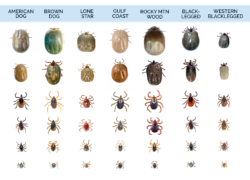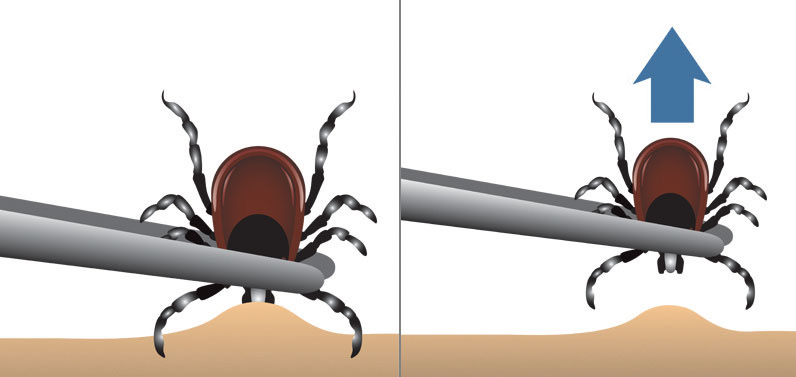 Lymes disease is a deadly and growing disease. It can be found throughout Nort America. Over a billion dollars a year are spent treating Lymes disease patients. Treatments often last for several months or longer.
Lymes disease is a deadly and growing disease. It can be found throughout Nort America. Over a billion dollars a year are spent treating Lymes disease patients. Treatments often last for several months or longer.
Lymes is the most occurring vector borne disease in the United States. There are 54 new cases per hour. The highest areas of infection are in the eastern states that include Maryland, Pennsylvania, Ohio, and Virginia.
Spring turkey hunting season is prime time for Lyme’s disease to spread. Most cases occur from April to October and are transmitted from ticks. The tiniest ticks are responsible for the most infections. Hunters handling big game, and birds, can easily encounter ticks. Be Tick Aware!
Other diseases are also spread by ticks such as Rocky Mountain Spotted Fever, Babesiosis, TBRF, Anaplasmosis, Ehrlichiosis, Rickettsiosis, Tularemia, Colorado Tick Fever, Powassan Virus disease and more.
On one hunt in Montana, I set up on a gobbler. He was reluctant to come close and I sat there for a few hours. When I stood up. My pant legs and coat were alive with hundreds of crawling ticks. I literally disrobed and gave myself a Tick Check in the middle of the forest! While I was standing their buck naked, the big Gobbler came into 20 yards and just watched. My gun was out of reach as I laughed and gave the Naked Truth to the Gobbler. I wonder what was going through his mind.
 The bacteria that cause this disease is found in the saliva of common dog and deer blood sucking ticks. A chemical in the tick’s mouth prevents blood from clotting, as they suck blood from a mammal, or human. This is when the disease is introduced to a new mammal host.
The bacteria that cause this disease is found in the saliva of common dog and deer blood sucking ticks. A chemical in the tick’s mouth prevents blood from clotting, as they suck blood from a mammal, or human. This is when the disease is introduced to a new mammal host.
Lymes disease is hard to detect. Many people get the illness and have minimal symptoms and require several tests to detect this bacterial disease. Minor symptoms can drag on for years, especially in pets. Others react severely with fever, rashes, weakness, and headaches. Long term infections can cause more severe outcomes. Antibiotics are used to tackle the Lymes bacteria but not everyone reacts the same to these harsh medicines.
Recently, the Genome–wipe Association Study looked at genes connected to the Lymes infections. They were able to identify 3 molecules that were involved between ticks and humans. The first two were of no surprise but the third garnered attention. SCGB1D2 is a molecule found in human sweat.
This human gene regulates inflammation and immune responses to infections. Increasing this protein provides protection and inhibits bacterial growth. The use of skin creams containing this sweat protein has helped patients that are resistant to antibiotics.
Study is continuing to find other delivery systems to prevent Lymes disease from infecting humans, pets, and other mammals.
You can use special sprays and insect repellents, but ticks find a way to gain a new host. “Tick Checks” are important to find the buried and engorged tick. A magnifier may be needed to find the tiny ticks. If allowed to fester the tick causes a red inflamed area that may also contain a red circle around the bite site. Hair, crevices, navels, armpits, and hard to see/reach areas are common bite sites. You may think that you just have a blemish/ pimple but take a closer look.
Usually, ticks can be felt walking on your skin. Dogs and other animals can also carry and spread the ticks. Deer ticks are extremely small. Ticks are also blind. They simply hang onto low plants looking to latch onto whatever comes by. Once aboard, they seek out warm damp places to ——-
If a tick is severely embedded in your skin, go to Urgent Care for removal. The old school way to remove a tick was using a hot, blown out match placed on their butts or covering them with Vaseline to prevent them from breathing, and encourage them to back out of your skin. Study has shown that these tactics just cause the tick to vomit more bacteria into your body.
The best bet is to get a tight grip on the tick and dig it out.Pointed tweezers help to grab the tick as close to the skin as you can. Sometimes you may tear out some human skin along with the whole tick. Remove the tick with a steady and consistent pull. without twisting or turning. If you break off the head and mouthparts, they will stay embedded in your skin and become infected. Use soap and water and rubbing alcohol to clean up the wound. Apply an antibiotic cream on the wound. If symptoms become an issue, get a blood test.
Ticks suck!
Montana Grant




